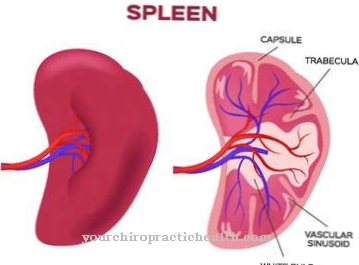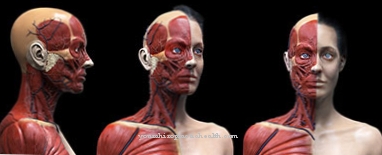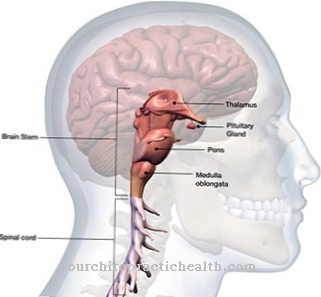The Lambert-Eaton-Rooke Syndrome, also known as LES is a very rare disease of the nervous system. The LES is one of the myasthenic syndromes.
What is Lambert-Eaton-Rooke Syndrome?
The Lambert-Eaton-Rooke Syndrome is also under the name Pseudomyasthenia known. The neurological disease is very rare. It was named after the American doctors Edward Howard Lambert, Lealdes McKendree Eaton and Edward Douglas Rooke. You first reported the disease in the 1950s. Muscle weakness is characteristic of Lambert-Eaton-Rooke syndrome.
causes
In Lambert-Eaton-Rooke syndrome, the B lymphocytes form antibodies against calcium channels. These are located in front of synapses on the so-called neuromuscular endplates. These motor end plates transmit excitation from a nerve to a fiber in the muscular system. The calcium tubules on the motor end plates are damaged by the antibodies. The neurotransmitter acetylcholine can no longer be released in sufficient quantities. Thus, the stimulus from the nerve fibers is only transmitted to the muscle cell in a weakened form. As a result, the muscle reacts very easily and slowly.
A malignant tumor can be found in about 60 percent of people with Lambert-Eaton-Rooke syndrome. In most cases, it is a small cell lung cancer (SCLC), a tumor of the prostate, a lymphoma or a tumor of the thymus gland. Since LES occurs in most cases in connection with tumors, it is also one of the so-called paraneoplastic syndromes.
Paraneoplastic syndrome is a symptom that accompanies cancer. The Lambert-Eaton-Rooke syndrome can occur in the very early stages. Often no tumor is known at the onset of the disease and the LES serves as the first indication of the cancer. About 40 percent of those affected have no tumor. This form of the syndrome is also known as the idopathic form because the cause is unknown.
The idiopathic form of LES is particularly found in patients who also suffer from other autoimmune diseases, such as systemic lupus erythematosus. Lambert-Eaton syndrome occurs in an average of 3.4 people per million people. Men are affected significantly more often than women. However, as more and more women develop lung cancer, the number of women with Lambert-Eaton-Rooke syndrome is also increasing.
Symptoms, ailments & signs

© HANK GREBE - stock.adobe.com
Muscle weakness of the extremities is typical of the LES. The arms are more often affected by this muscle weakness than the legs. In particular, the muscles of the thighs, hips and knees suffer. Patients therefore often notice their first weaknesses when climbing stairs. But the trunk muscles can also be affected in Lambert-Eaton-Rooke syndrome. It is also characteristic that, despite the muscle weakness, no sensitive disorders can be found.
The LES is often confused with myasthenia gravis when making a diagnosis. Muscle weaknesses also occur here. However, the LES lacks the paralysis of the eye muscles that is characteristic of myasthenia gravis. Paralysis of the eyelids (ptosis) is also rather rare. In addition to muscle weakness, symptoms such as dry mouth, headache, impotence, constipation or urination disorders can occur.
Cognitive disorders are an indication of involvement of the autonomic nervous system. These occur in more than 90 percent of the cases. The central nervous system can also be affected. Other symptoms include decreased sweating, changes in blood pressure and blurred vision.
Diagnosis & course of disease
The suspicion of Lambert-Eaton-Rooke syndrome is checked with a neurophysiological examination. As an indication of the muscle weakness, there are reduced motoric cumulative action potentials. These deviations can also be observed in the muscles that are not (yet) affected by the weakness. If the peripheral nerves are stimulated by high frequency or by strong muscular stress, it can be observed that the strength in the muscles increases significantly.
This phenomenon is also known as Lambert's sign. The Lambert's sign is also used for the differential diagnosis of myasthenia gravis. A fatigue of the muscle can be observed here with strong stimulation. In addition to these tests, a tensilon test can also be performed. A cholinesterase inhibitor is injected intravenously into the patient. He then has to repeat various muscle exercises.
If the maximum strength of the muscles after the administration of Tensilon is higher than before, the test is positive. A positive test result is found in both myasthenia gravis and Lambert-Eaton-Rooke syndrome. In addition, laboratory tests can confirm the diagnosis. In almost 90 percent of all those affected, the causative antibodies are found in the blood. If the suspicion of the LES is confirmed, it is essential to look for a causal tumor. More than 95 percent of all malignant tumors are found in the year after diagnosis.
Complications
Due to Lambert-Eaton-Rooke syndrome, those affected primarily suffer from pronounced muscle weakness. The patients seem exhausted and continue to suffer from a German reduced resilience. This leads to significant restrictions in various activities in everyday life, so that those affected find it difficult to walk or climb stairs.
The eyelids can also be paralyzed, leading to various visual problems. Furthermore, the patients suffer from headaches and impotence due to the Lambert-Eaton-Rooke syndrome. This not infrequently also leads to psychological complaints or depression.
Because of the discomfort in the eyes, those affected also suffer from blurred vision. It also leads to decreased blood pressure, which can also lead to a loss of consciousness. The patient's quality of life is significantly reduced and restricted by Lambert-Eaton-Rooke syndrome.
As a rule, the underlying disease is always treated in Lambert-Eaton-Rooke syndrome. As a rule, it cannot be universally predicted whether this will lead to a positive course of the disease. Lambert-Eaton-Rooke syndrome may also significantly reduce the patient's life expectancy.
When should you go to the doctor?
Lambert-Eaton-Rooke syndrome can manifest itself through various health problems that require clarification. If symptoms such as muscle weakness in the extremities, incontinence, constipation or headache develop, a doctor must be consulted. The same applies to unusual visual disturbances, blood pressure fluctuations and other unspecific symptoms that cannot be clearly traced back to a trigger. Affected people should speak to their family doctor immediately so that the disease can be clarified and treated quickly. If this happens early, long-term damage and serious complications can often be ruled out.
Cancer patients, people with autoimmune diseases and the elderly or debilitated are particularly prone to developing Lambert-Eaton-Rooke syndrome. Those who belong to these risk groups should go to the responsible doctor with the symptoms described. In addition to the family doctor, the disease of the nervous system must be treated by various specialists such as neurologists, ophthalmologists, orthopedists and internists. In addition, physiotherapists and psychotherapists are included in the treatment in order to be able to treat any movement disorders or subsequent psychological complaints. Regular visits to the doctor are indicated during therapy.
Therapy & Treatment
If the Lambert-Eaton-Rooke syndrome is based on a tumor, it must be treated. This often improves the symptoms of the LES. However, if the muscle weakness progresses, drugs such as pyridostigmine, intravenous immunoglobulin or amifampridine can be used. However, the effectiveness of these agents in Lambert-Eaton-Rooke syndrome has not yet been adequately proven scientifically.
The idiopathic form can be improved by immunosuppressive drugs such as glucocorticoids or immunoglobulins. Symptomatic therapy is carried out with potassium channel blockers. In addition, the blood can be cleaned of the antibodies during plasmapheresis. This also improves the symptoms.
You can find your medication here
➔ Medicines for muscle weaknessOutlook & forecast
The prognosis of Lambert-Eaton-Rooke syndrome depends on the causal disorder. In a large number of cases, those affected suffer from a tumor disease. An improvement in health can only be achieved if the tumor has been completely removed. This requires cancer therapy, which is associated with numerous risks and side effects. The surgical removal of the tumor must be carried out and can also be associated with complications. However, only the cure of the tumor brings the prospect of a full recovery.
If an autoimmune disease is present, the course of the disease is often chronic. Long-term therapy relieves the symptoms by administering herbs. The medication can have side effects and thus also have a negative effect on the general well-being of the person concerned. Nevertheless, they show the only way that basically leads to an alleviation of the Lambert-Eaton-Rooke syndrome. If there is an intolerance to an active ingredient, an alternative preparation should be found and administered. This will reduce the risk for possible side effects.
Since the course of the syndrome is characterized by various complaints and limitations, various secondary diseases can develop. For many patients, the emotional burden is so severe that psychological disorders develop. This possible development must be taken into account when making the overall forecast.
prevention
Preventing Lambert-Eaton-Rooke syndrome is rather difficult. Since the syndrome is often the result of a lung tumor, the risk factors for lung cancer should be avoided. First of all, smoking should be mentioned here. A healthy lifestyle, on the other hand, can have a positive effect on the risk of cancer.
Aftercare
Lambert-Eaton-Rooke syndrome is usually associated with severe complications and symptoms, so that the options for follow-up care are very limited in most cases. Those affected should therefore primarily consult a doctor so that a quick diagnosis can be made. Only an early diagnosis can prevent the symptoms from worsening.
In most cases, patients with Lambert-Eaton-Rooke syndrome are dependent on taking medication to permanently relieve the symptoms. It is always important to ensure that it is taken regularly and that the dosage is correct. Should any questions or ambiguities arise regarding the medication, a doctor should always be consulted first.
Help and support from one's own family and acquaintances is also very important with Lambert-Eaton-Rooke syndrome and can above all prevent psychological complaints or even depression. Loving and intensive discussions have a positive effect on the course of the disease. In the case of a tumor, the syndrome usually cannot be completely cured. The life expectancy of the person affected may also be significantly reduced due to the underlying disease.
You can do that yourself
Patients with Lambert-Eaton-Rooke syndrome suffer from considerable muscle weakness, which gradually makes it more and more difficult for them to carry out their day-to-day business and significantly reduces the perceived quality of life. In order to help themselves, those affected first take advantage of physiotherapy after their doctor's visit in order to sound out the motor skills they still have and to strengthen them in a targeted manner. For this purpose, the patients perform exercises prescribed by the therapist in their own four walls and thereby increase the success of the physiotherapy.
Patients also use walking aids to help balance and reduce the risk of falls. Those affected also counteract the increased risk of accidents by paying more attention to physical activities. If the impairments in everyday life are too great, the patients seek the help of a nursing service or relatives.
The treatment of the disease usually also includes the disciplined use of various medications, which is the responsibility of the patient. Most of the time, eyesight is also impaired by the disease, so special visual aids and eye treatments can help to a certain extent. However, the disease leads to psychological complaints such as depression in a large number of those affected, so that the patients turn to a psychological therapist.




























